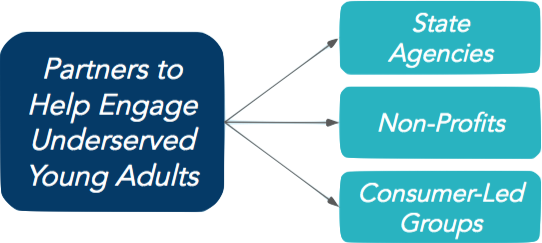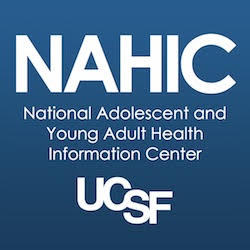Strategy 2: Build Collaborative Networks
How Do Collaborations Help?
By bringing stakeholders with diverse expertise together, collaborations enable more effective use of resources to address young adult health. These synergies in turn benefit Title V programs, partners and people served by Title V. There are near-endless possibilities to how Title V programs can collaborate to improve YA health. Below are some benefits of collaboration to stakeholders:
| Benefits to Title V agencies: |
|
| Benefits to Partners: |
|
| Benefits to Individuals: |
|
Factors for selecting partners include their capacity to commit to the project, connection to the target population and shared goals. To help states identify partners that are most appropriate for their selected YA initiative, this section is arranged by topic area: Youth & Communities, Higher Education & Workplace and Health Insurers & Healthcare Organizations. We then discuss opportunities for statewide, interdisciplinary adolescent & young adult health (AYAH) networks to facilitate lasting partnerships.
✔ Engage Youth & Communities

Directly hearing from communities is a prerequisite to effectively serving them. Title V and other organizations can be more responsive to young adults’ health needs by collaborating with them throughout the development of YA health services. States can identify youth partners by engaging YA community groups and organizations that work with underserved young adult populations.
Youth Advocacy & Community Groups
Organizations that engage a large number of young adults include:
- YMCA and YWCA: run varied wellness and social programs
- Youth MOVE: focuses on positive youth development
- Advocates for Youth: dedicated to sexual/reproductive health
- Young Invincibles: key issues include healthcare, workforce and education
- Partnership for Male Youth: promotes health of young men
States may also wish to collaborate with LGBTQI and cultural organizations, including the Gay-Straight Alliance and ethnic cultural identity groups in colleges.
Underserved Young Adults & Youth with Special Healthcare Needs (YSHCN)
Youth with special healthcare needs, foster care alumni, incarcerated young adults and other underserved YAs have unique circumstances that affect their health and ability to seek care. Additionally, they may not have many opportunities to have their voices heard. Title V programs should take extra care to reach out to these populations and incorporate their perspectives into YA health strategies.
| Preparing Foster Youth for Success |
| North Carolina’s Forsyth County Department of Social Services has partnered with nonprofit, Youth in Transition, to support transition age foster youth (TAFY) and foster care alumni up to their 26th birthday. Youth in Transition offers programming around seven core transition goals, one of which is to improve the physical and mental health of TAFY in their region. Learn more |
As Title V programs already have programs geared toward YSHCN, they can use this infrastructure to identify young adults with special healthcare needs to share input on proposed strategies. Potential external organizations to partner with include the AAP’s National Resource Center for Patient/Family-Centered Medical Home, Family Voices and Partners for Youth with Disabilities.
Title V can utilize multiple avenues to engage underserved young adults. For example, by collaborating with one’s state Department of Justice, Housing and/or Department of Social Services, Title V can reach young adults served by these agencies. Besides government partners, Title V can work with nonprofits such as First Place for Youth, Root & Rebound and local homeless shelters, or consumer-led groups such as Foster Care Alumni of America. These organizations offer avenues to reach young adults who might otherwise not engage with Title V. Such partnerships may also be used to expand access to health services.

To promote lasting collaboration with communities, states may consider establishing a youth advisory council including young adults from all walks of life. One example of a youth advisory council is Vermont RAYS, a group of young people that works with the Youth Health Improvement Initiative to coach primary care practices on improving AYA health services.
↑ (back to top)
✔ Partner with Higher Education & Workplace Organizations
Department of Education & Department of Labor
Engaging the Departments of Education and Labor offers a unique opportunity to address colleges and workplaces across your entire state. In Maine, Title V has worked with its Department of Labor over several years to disseminate substance use prevention materials, hold educational workshops at companies and launch surveys on tobacco use. Given that most young adults are working and/or in higher education, collaboration with these agencies helps maximize reach to YAs.
Educators
University & community college educators interact regularly with YAs, and hear firsthand the stressors this population faces. Additionally, many colleges have peer health educator groups, discussed further in Strategy 4, that would be great partners. Recognizing high rates of youth suicide in its state, Rhode Island’s Title V program has collaborated with educators for early intervention in youth depression.
| Training Educators to Prevent Suicide |
| In Rhode Island, Title V has developed a network of partners to train educators of 15-24 year olds on suicide prevention. The RI Youth Suicide Prevention Project (RIYSPP) coordinates its trainings with input from education professionals, with the aim of helping teachers identify and address signs of depression and suicidality. Through this approach, Rhode Island expects to train up to 42 public schools by end of 2019. Learn more |
Employers & Colleges
Colleges and workplaces have a large impact on young adults’ day-to-day lives through the policies, programs and culture they establish. Additionally, Title V has had a history of success in collaborating with academic institutions to disperse health education materials, facilitate workshops and develop evidence-based programming. Novel ways to leverage this relationship include working with a college’s Reserve Officer Training Corps program or Educational Opportunity Program to reach populations of interest.
While collaborations with businesses are not common among state programs, they offer new opportunities to engage young adults – especially those who are not in school. Partnerships may start simple, for example by having pamphlets distributed in offices, but can expand into an ongoing dialogue promoting employee wellness. To reach young adults, it is recommended to work with employers – such as grocery stores, retailers & the military – that tend to hire YAs.
✔ Work with Health Insurers & Healthcare Systems
Health Insurers
Collaborations with major health insurers in your state can influence reimbursement and receipt of young adult healthcare services. Medicaid is a particularly ideal partner for Title V due to its commitment to low-income populations. Introduced by federal regulation and supported by the Health Resources and Services Administration, Interagency Agreements (IAA) between Title V and Medicaid formalize the shared responsibilities of each party.
The majority of IAAs entail data sharing. Additionally, states can share screening materials and/or train staff in both agencies to coordinate care for patients who may benefit from both Title V and Medicaid services. Other collaborative opportunities include developing educational materials, holding workshops and facilitating webinars on YA health.
In the realm of private health insurance, companies such as Blue Cross & Blue Shield have taken on healthcare quality improvement initiatives that synergize with Title V’s goals. For example, Alabama’s Blue Cross & Blue Shield has provided financial incentives for adolescent vaccines. Similar initiatives could be expanded to young adults to combat their low healthcare utilization rates. By partnering with private health insurers, Title V can increase its impact on the two-thirds of insured Americans who have private coverage.11
| Transforming Preventive Services for Young Adults |
| The Oregon Health Authority Transformation Center is an institution housed under the state’s Medicaid agency that works collaboratively with OR’s Title V program. The Transformation Center has produced a series of materials on how to increase well-visits for young adults aged 18-21. These include the promotion of innovative partnerships between coordinated care organizations and community colleges. Learn more |
Healthcare Systems & Professional Associations
In addition to working with insurers, Title V can work directly with healthcare systems and professional associations on improving access to and quality of care. These collaborations may range from working with rural providers to increase preventive visit rates to partnering with a local American Academy of Family Physicians chapter to promote STI screening for young adults.
Healthcare professional associations relevant to young adult health include:
- American Academy of Pediatrics
- American Academy of Family Physicians
- American Nurses Association
- American College of Obstetricians & Gynecologists
- National Association of Social Workers
Collaborations with healthcare delivery systems and professional associations may be particularly ideal for capacity building, quality improvement and training initiatives. While Title V programs benefit by directly impacting youth-serving professionals in their state, members of professional associations also benefit from free educational opportunities and improvements in their work/practice.
| Successful Healthcare Transition with PEACH-T |
| The Georgia Partnership for Ensuring Adolescent Comprehensive Healthcare Transition (GA PEACH-T) is a collaborative effort to successfully transition youth with special healthcare needs from pediatric to adult healthcare. PEACH-T was established as a partnership of the Georgia Department of Public Health, Children’s Healthcare of Atlanta, Georgia Regents University, Georgia Academy of Family Physicians and other entities. Learn more |
✔ Develop Interdisciplinary, Statewide Adolescent & Young Adult Health (AYAH) Collaboratives

Statewide collaboratives like the Youth Health Improvement Initiative – which incorporates Vermont’s Title V agency, Children’s Health Improvement Program, Medicaid and private insurers – have brought together stakeholders from diverse areas to improve adolescent & young adult health (AYAH) education and services. Title V agencies can join or develop their own statewide young adult health collaboratives in order to sync strategies across organizations and share the latest developments.
Title V programs are encouraged to think outside the box when developing partnerships. While the collaborations shared in this section cover a wide range of possibilities, there may be excellent partners in your state not listed here. Some examples of innovative partnerships include working with the military on fitness and nutrition education, or developing a marketing campaign with the Department of Transportation on the dangers of driving under the influence of marijuana. Adolescent Systems Assessment and Strategic Planning tools for states may be adapted to guide efforts to form Networks to advance young adult health.
→ next: Strategy 3 – Provide Training on YA Health
 University of California San Francisco
University of California San Francisco


